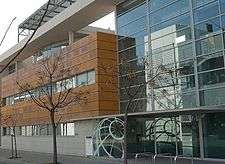Institute of Geomatics
The Institute of Geomatics (IG) was a public consortium made up of the Autonomous Government of Catalonia (Ministry of Territory and Sustainability, and the Ministry of Economy and Knowledge) and the Polytechnic University of Catalonia,[1] created by Decree Law 256/1997 of the Autonomous Government of Catalonia, on September 30, 1997. It was a founding member of the Associació Catalana d'Entitats de Recerca (ACER).
 Institute of Geomatics headquarters at Castelldefels. | |
Other name | IG |
|---|---|
| Established | 1997 |
| Director | Ismael Colomina i Fosch |
| Address | Avinguda de Carl Friedrich Gauss 11 , , 41°16′29.2″N 1°59′12.1″E |
| Campus | Mediterranean Technology Park |
| Website | www |
The Institute of Geomatics was dissolved on December, 31st 2013, following the Government Agreement of Dissolution signed on December, 23rd 2013. The institute, including personnel, equipment and developments, was integrated as the Geomatics division of the Centre Tecnològic de Telecomunicacions de Catalunya.[2]
Activities
The institute's mission was the "promotion and development of Geomatics, through applied research and teaching, for the benefit of society".
Within the framework defined by its mission, the institute mainly conducted the following activities:
Vision on Research
The Institute of Geomatics was a public non-profit research center. Since 1999 it worked intensively on research, knowledge transfer and dissemination of geomatic science and technology.
Geomatics is a variety of techniques that integrate sensors capturing data and images (mainly cameras, but also from other remote sensors) with methods for the treatment, analysis, interpretation, diffusion and storage of geographic information.
Geomatics connects various traditional disciplines, like geodesy or cartography with more recently developed fields like remote sensing, satellite navigation and latest information and communication technologies. As a result, geomatics allows us today to obtain information about the Earth and its atmosphere globally and within very short time.
The Institute centered its activities around two main areas: the area of positioning and navigation, focused on techniques to improve precision, and the area of remote sensing, which means Earth observation through images and data collected by sensors on-board of satellites, aircraft and ground platforms.
More specifically, the IG research lines entailed:
- Remote Sensing and Photogrammetry, including ground, airborne and/or satellite observation systems, sensor and acquisition systems' technology, geometric and radiometric data normalization, and information extraction and fusion from data
- Geodesy, including spatial and inertial geodesy, high precision static and kinematic positioning, and gravity field determination
- Cartographic modelling and representation, including technology and application of Geographic Information Systems for spatial data integration and exploitation
- Navigation, including Global Navigation Satellite Systems, Inertial Measurement Units, and multi-sensor integration for applications in transportation, agriculture, search-and-rescue and airborne remote sensing
The IG participated in a wide portfolio of research projects, covering areas such as cartography,[6] topography,[7] search-and-rescue,[8] civil engineering,[9] agriculture, mobile mapping, location-based services,[10] unmanned aerial vehicles,[11] and many others.
References
- "List of UPC groups categorized in knowledge areas". UPC. November 2013. Archived from the original on 2013-12-24. Retrieved 2014-01-21.
- "Webpage of the Centre Tecnològic de Telecomunicacions de Catalunya". CTTC. January 2014. Retrieved 2014-01-21.
- "Announcement by Ingenieria Dei Sistemi (IDS) of the course Ground-Based SAR for Deformation Monitoring: Data Analysis, taught by IG". IDS. July 2013. Retrieved 2014-01-21.
- "Report from the European Spatial Data Research / International Society of Photogrammetry and Remote Sensing, about the EuroCOW (European Calibration and Orientation Workshop), a scientific workshop organized biennially by the IG" (PDF). ISPRS. March 2012. Retrieved 2014-01-21.
- "Announcement by the International Society of Photogrammetry and Remote Sensing of the 6th edition of the International Geomatic Week, a congress organized biennially by the IG". ISPRS. 2005. Retrieved 2014-01-21.
- "uVISION, a new concept for collecting, processing and representing geoinformation". TeleSpazio. 2014. Retrieved 2014-01-21.
- "Mapping Tarragona's underground cunniculus". ICAC. March 2012. Retrieved 2014-01-21.
- "Final tests of CLOSE-SEARCH: successful unmanned aerial platforms in search missions". GNSS Supervisory Authority. 2012-05-04. Retrieved 2014-01-21.
- "Measuring land deformation after Japan's earthquake". GenCat. 2011-04-07. Archived from the original on 2014-02-01. Retrieved 2014-01-21.
- "The IEGLO project: Infrastructure-Augmented EGNOS/Galileo Receiver for Personal Mobility". TeleCosult Austria GmbH. 2010. Retrieved 2014-01-21.
- "Presentation held at the École Polytechnique Fédérale de Lausanne by IG's director, named UAV for Geomatics Applications: The Challenges". EPFL. 2012-10-16. Retrieved 2014-01-21.